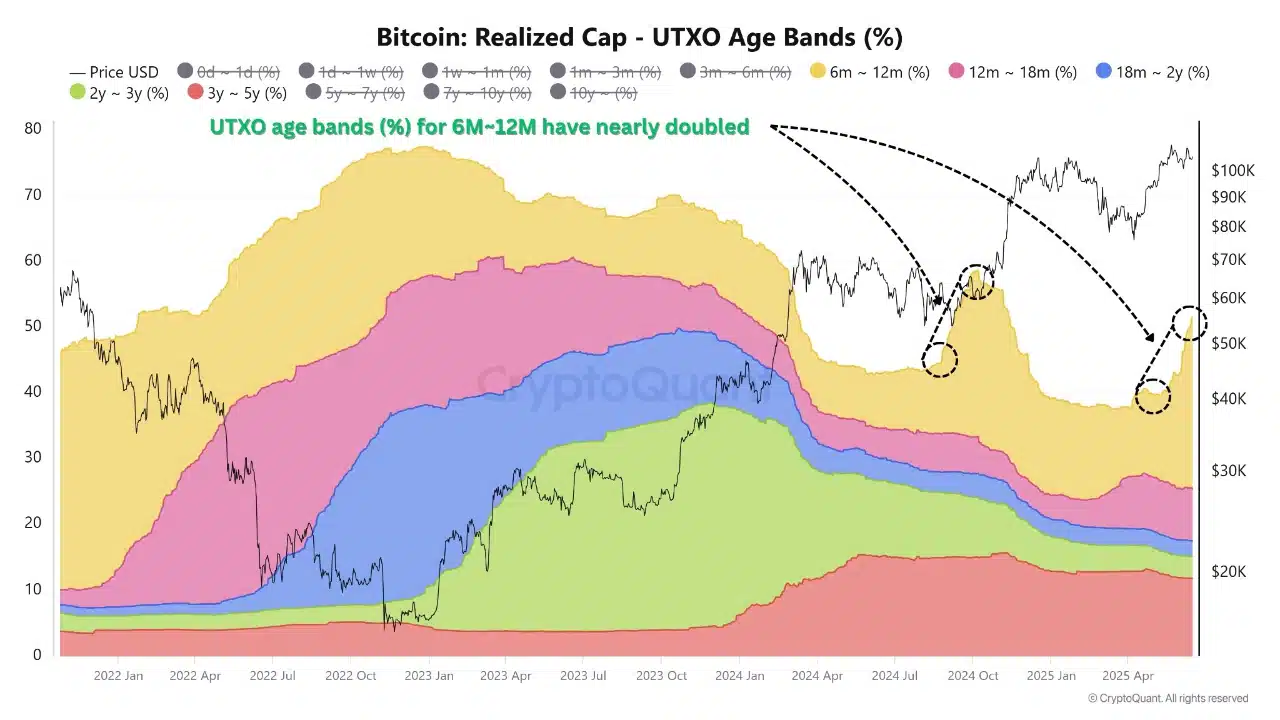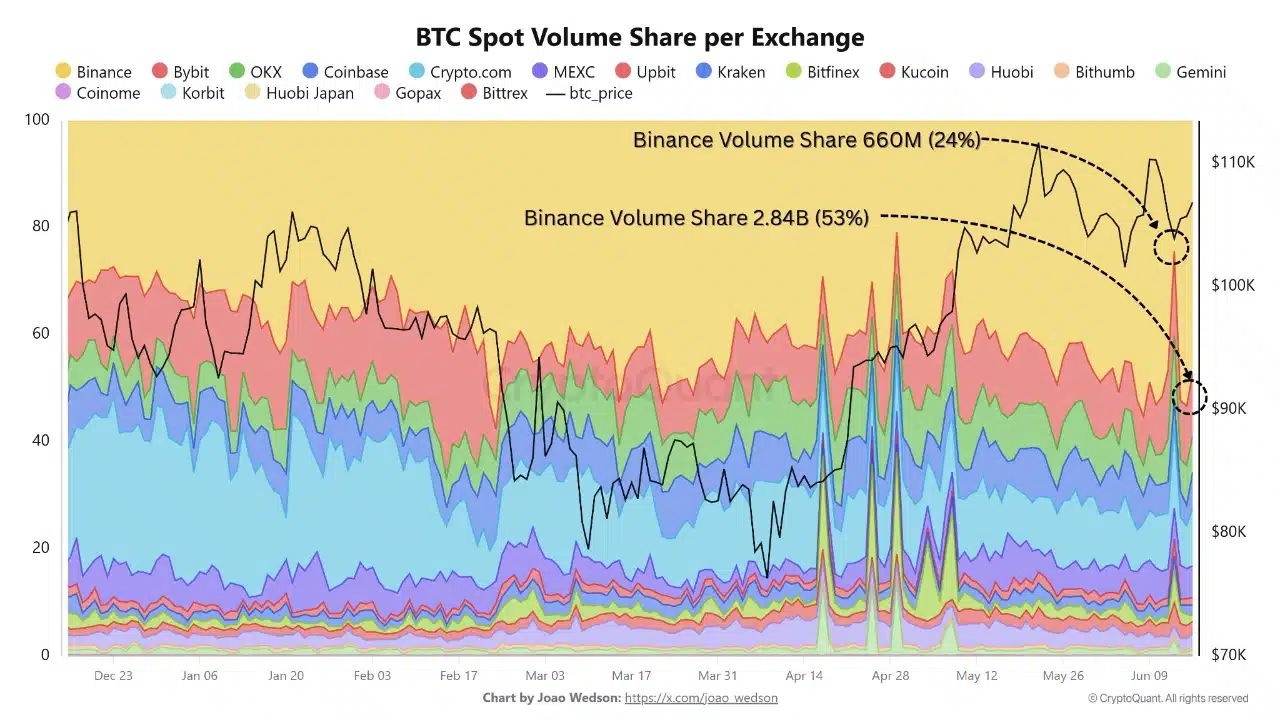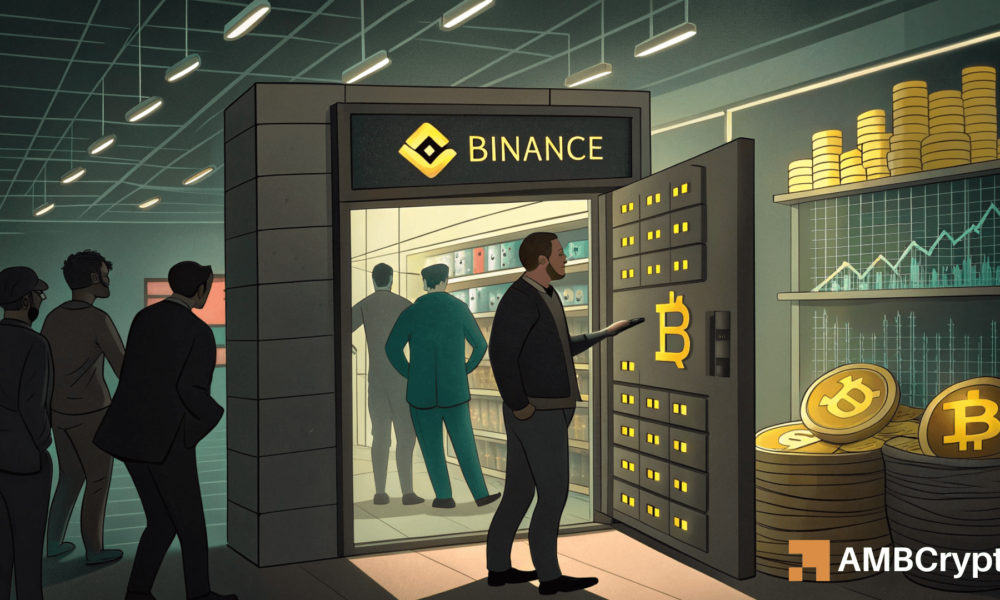- Binance volume surged while mid-term holders doubled, signaling rising institutional accumulation.
- Crowd interest and leverage dropped, highlighting market indecision and weak demand momentum.
Bitcoin’s [BTC] UTXO band has doubled from 6 million to 12 million in June, indicating rising holder conviction despite BTC dropping 1.79% to $104,950, a press time, over the last 24 hours.
This spike shows that more investors are opting to hold through volatility rather than take profits, reducing available supply.
Historically, such behavior from mid-term holders—often considered smart money—has preceded strong rallies. If this trend continues, Bitcoin could build a bullish setup based on accumulation.
However, short-term demand remains fragile, and traders should remain cautious until key confirmation signals return.


Source: CryptoQuant
Why is Binance absorbing most of the spot market activity?
Binance’s share of Bitcoin spot trading volume has surged from 24% to 53% in just one day—a dramatic shift, pointing to a massive influx of capital.
This spike is likely driven by institutional players reallocating their activity, drawn by Binance’s deep liquidity and cost-effective trading structure.
Such a sudden rise in exchange dominance often signals an impending high-volatility phase, especially if fueled by coordinated accumulation or strategic positioning ahead of major price moves.
Additionally, this rapid consolidation of volume highlights growing centralization in crypto trading infrastructure.
If sustained, it could have lasting implications for price discovery and market dynamics.


Source: CryptoQuant
Does a Stock-to-Flow ratio of 580 confirm extreme scarcity for BTC?
At the time of writing, Bitcoin’s Stock-to-Flow (S/F) ratio surged to 580—a level well above historical averages.
This metric measures the relationship between Bitcoin’s circulating supply and its annual issuance, and such a sharp increase typically points to tightening supply and long-term bullish potential.
However, the elevated reading may be skewed by factors like reduced miner selling or short-term fluctuations in on-chain activity.
While a high S/F ratio supports the narrative of a looming supply shock, it’s not a standalone signal for price appreciation.
Sustained price growth still depends on rising demand and broader market participation.
Without renewed investor interest and increased activity, elevated S/F levels alone may fall short of sparking immediate upside momentum.


Source: Santiment
BTC social and derivatives metrics show indecision as conviction stalls
BTC’s Social Dominance dropped to 19.88% while Binance Funding Rate hovered at a neutral 0.001%, reflecting fading crowd engagement and trader indecision.
This combination suggests a low-conviction environment, where neither bulls nor bears are assertively in control.
Historically, falling social interest paired with flat funding has preceded major volatility as markets await catalysts. The lack of extreme sentiment or leverage reduces short-term breakout momentum.
Therefore, without a spike in engagement or directional funding, Bitcoin may remain range-bound. If these metrics shift sharply, they could signal the start of Bitcoin’s next big move.


Source: Santiment
Negative DAA Divergence still persists despite recent price stability
The Price-DAA Divergence remained negative, suggesting that address activity has not kept up with recent price movements.
This persistent divergence raises concerns about the strength of the current market structure.
Typically, growing address activity supports sustainable rallies, while divergence often signals speculative or hollow price action.
The continued gap implies fewer unique users are transacting on the network, despite price hovering above $100K.


Source: Santiment
Which force will prevail—conviction or exhaustion?
Bitcoin’s market is currently caught between opposing forces: strong accumulation by long-term holders and waning interest from the broader crowd.
Mid-term UTXO growth and Binance’s rising market share point to increasing institutional confidence and long-term conviction.
On the flip side, negative divergence in Daily Active Addresses (DAA), muted social sentiment, and neutral funding rates expose weak retail engagement.
For BTC to stage a sustainable breakout, alignment between institutional accumulation and retail enthusiasm is essential.
Until that balance emerges, Bitcoin remains at a pivotal point—hovering between the potential for a breakout and the risk of market fatigue.







